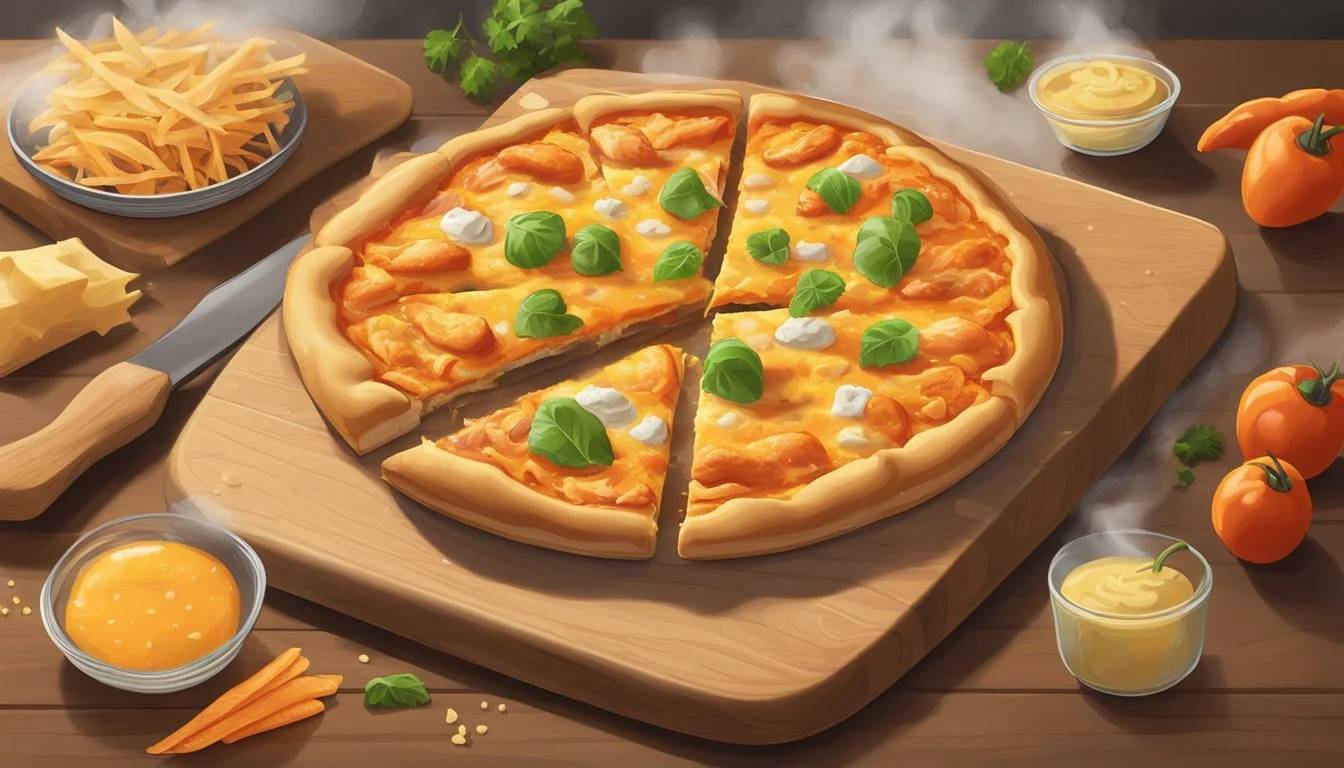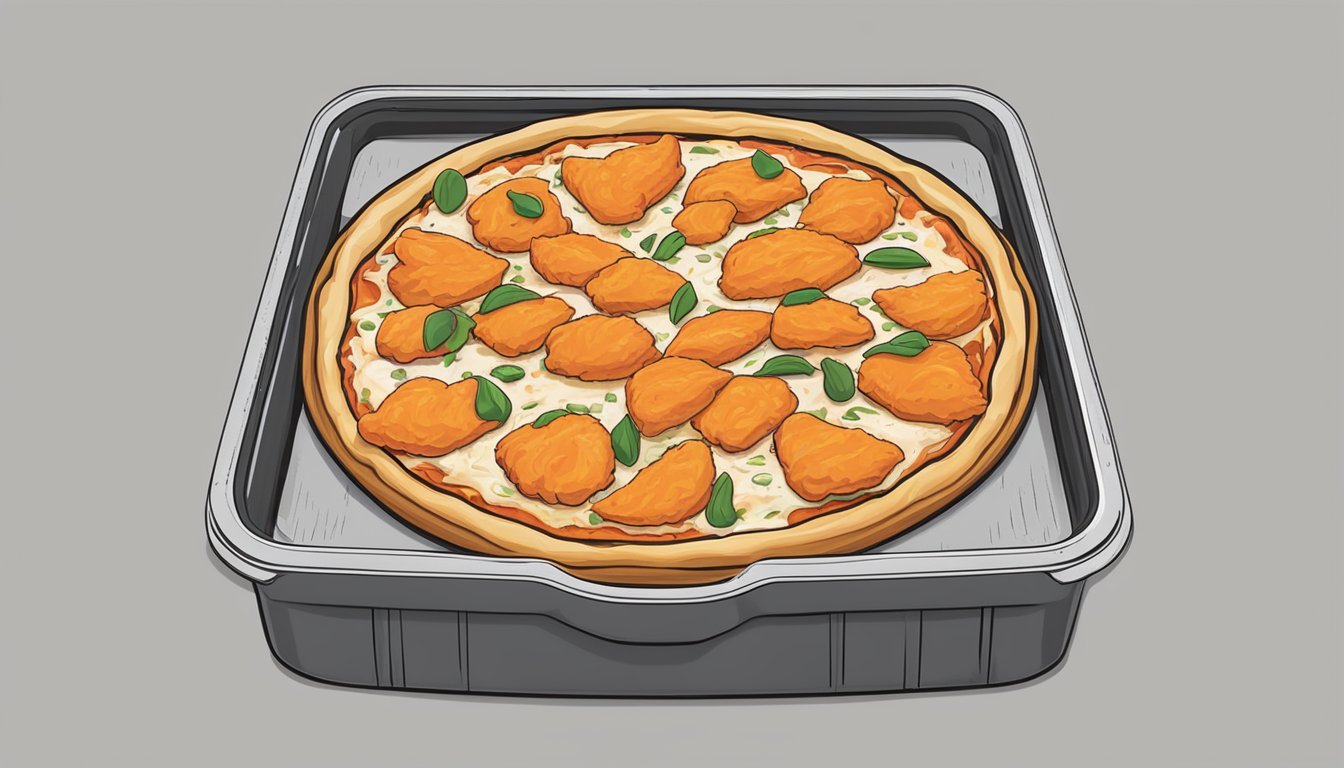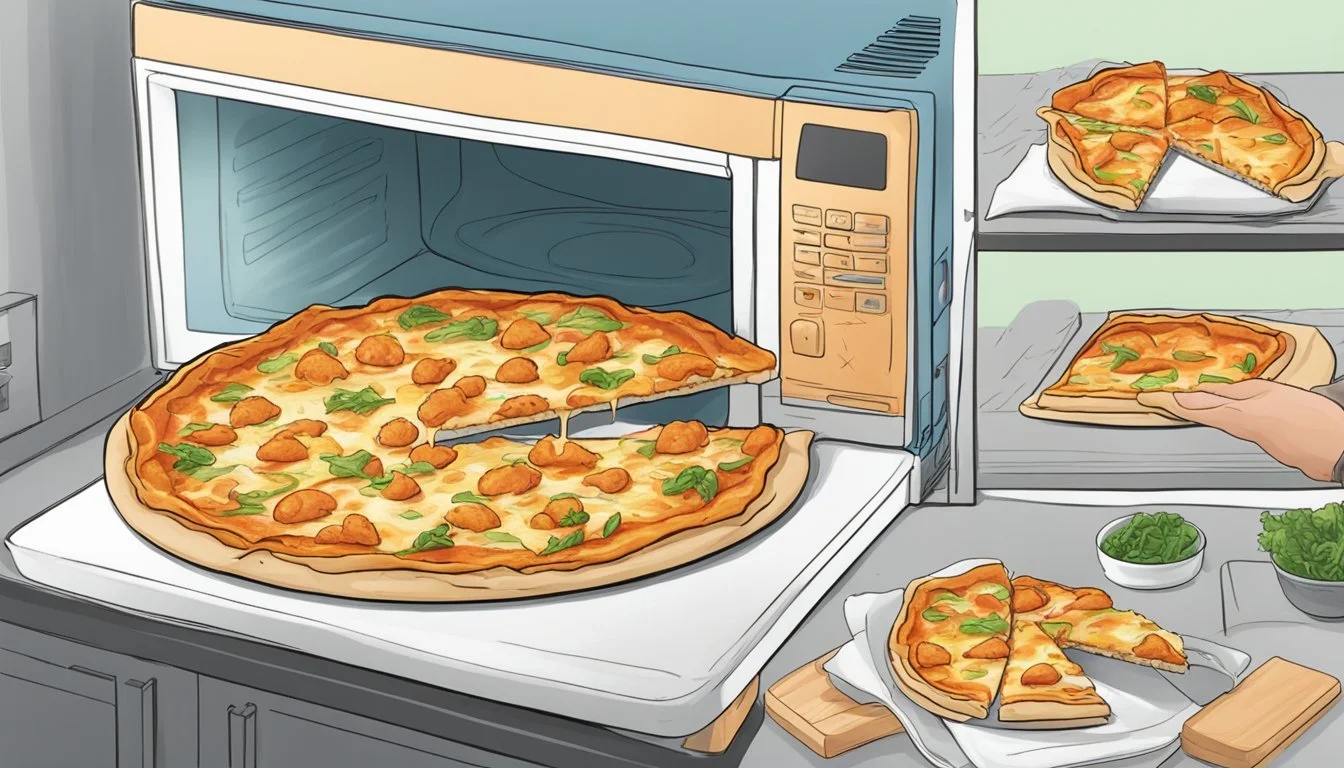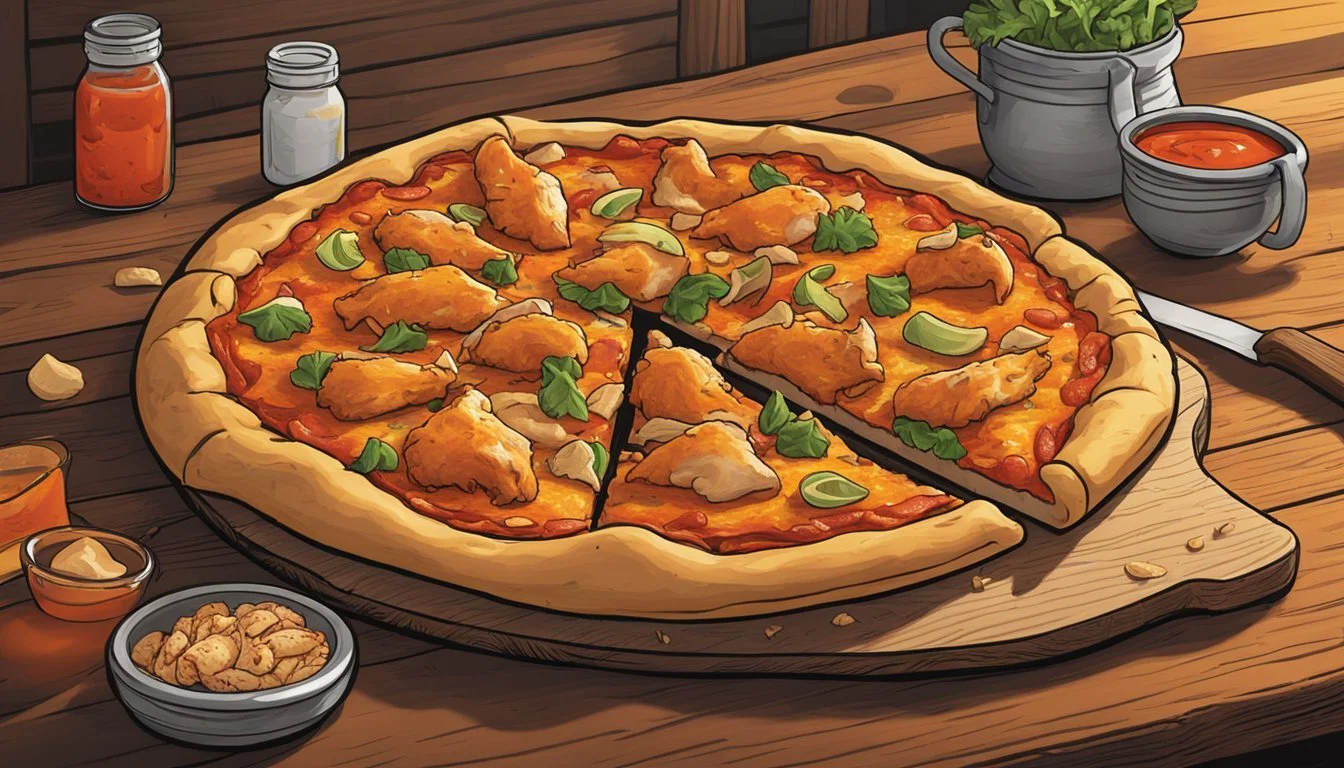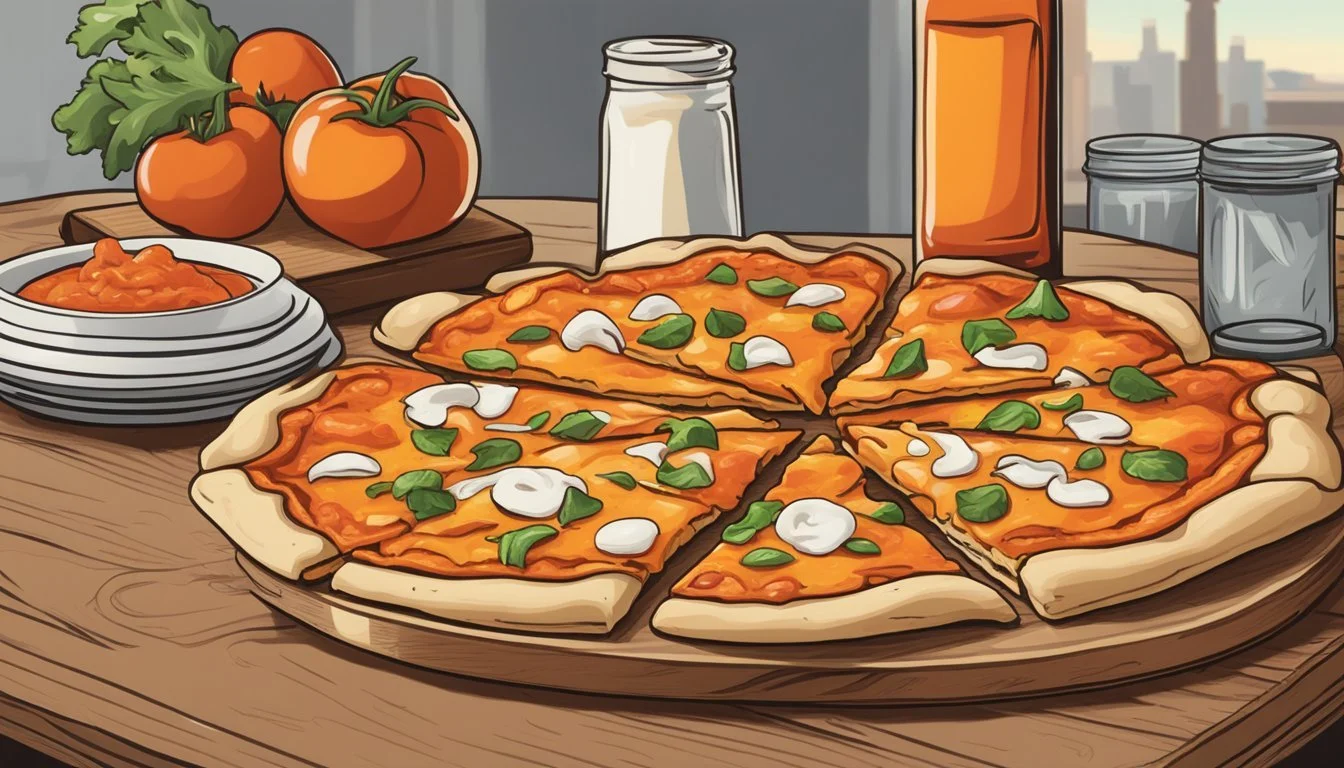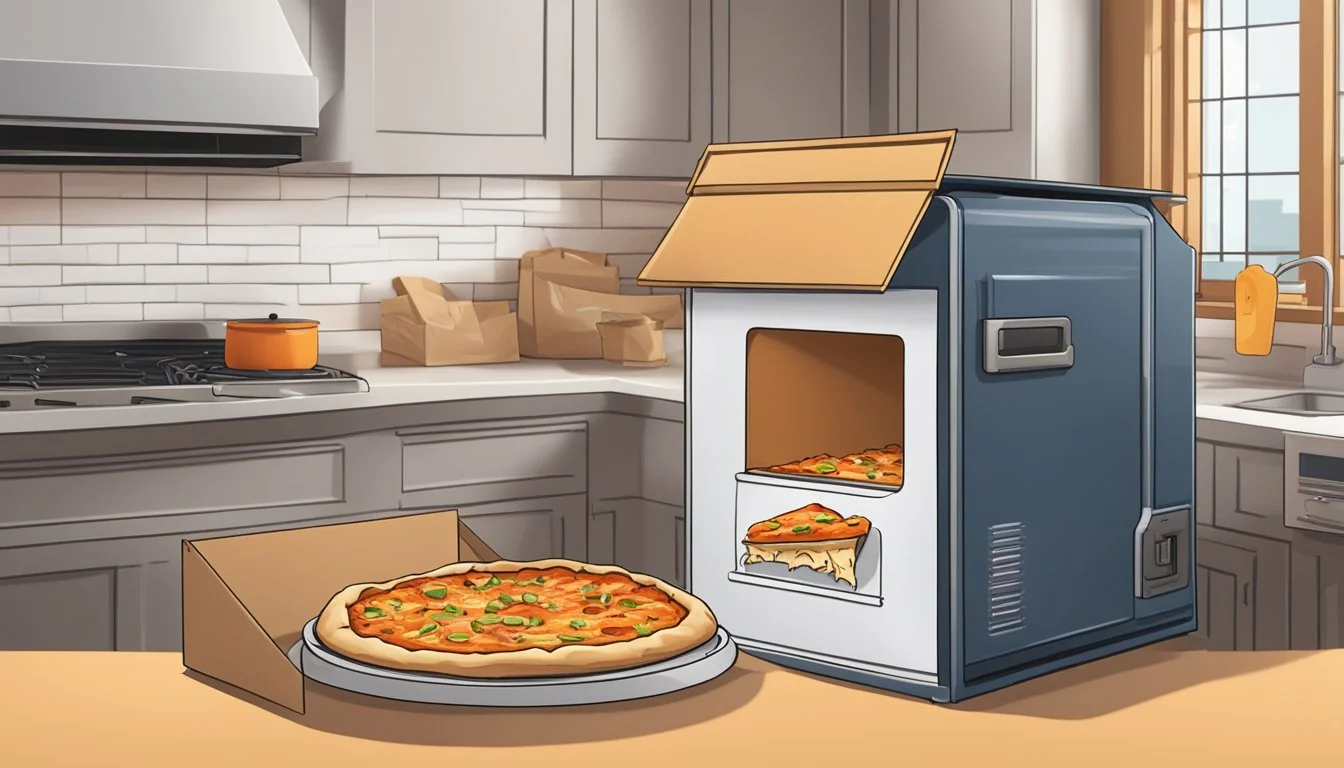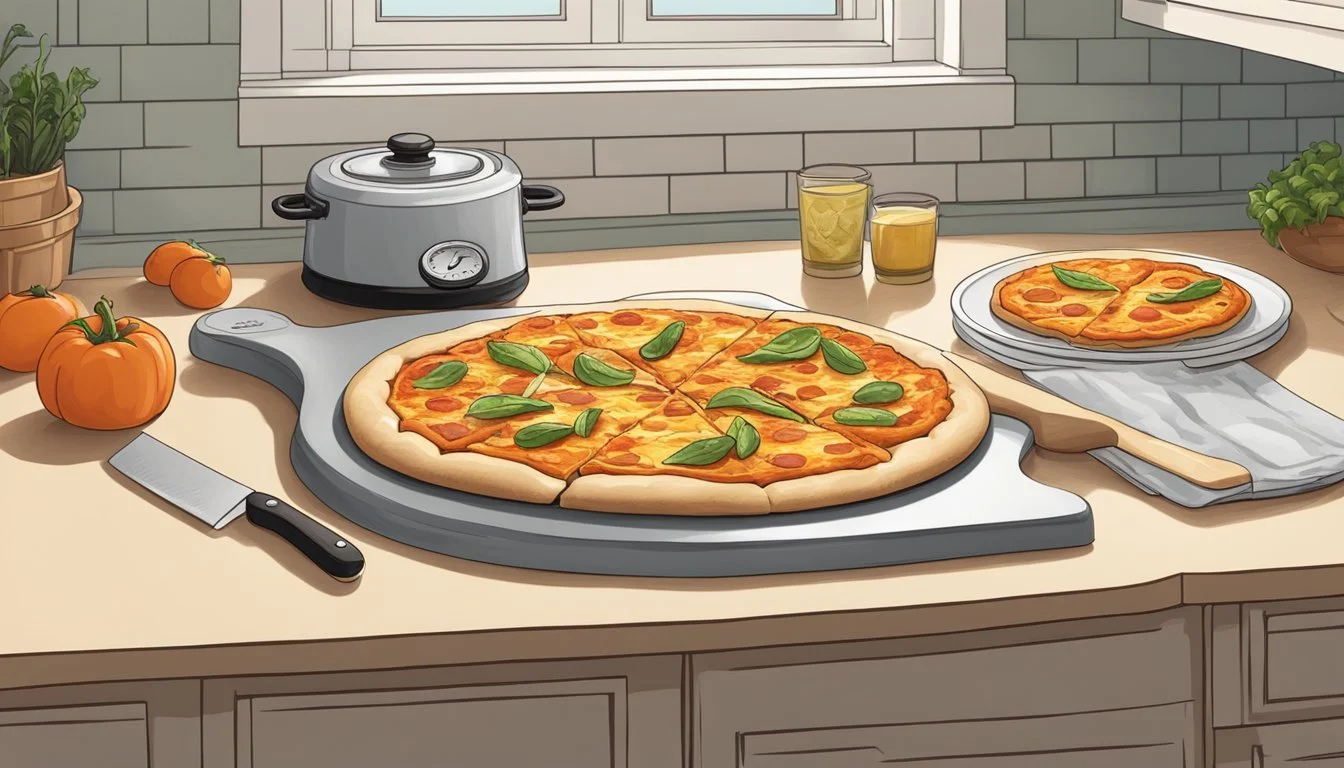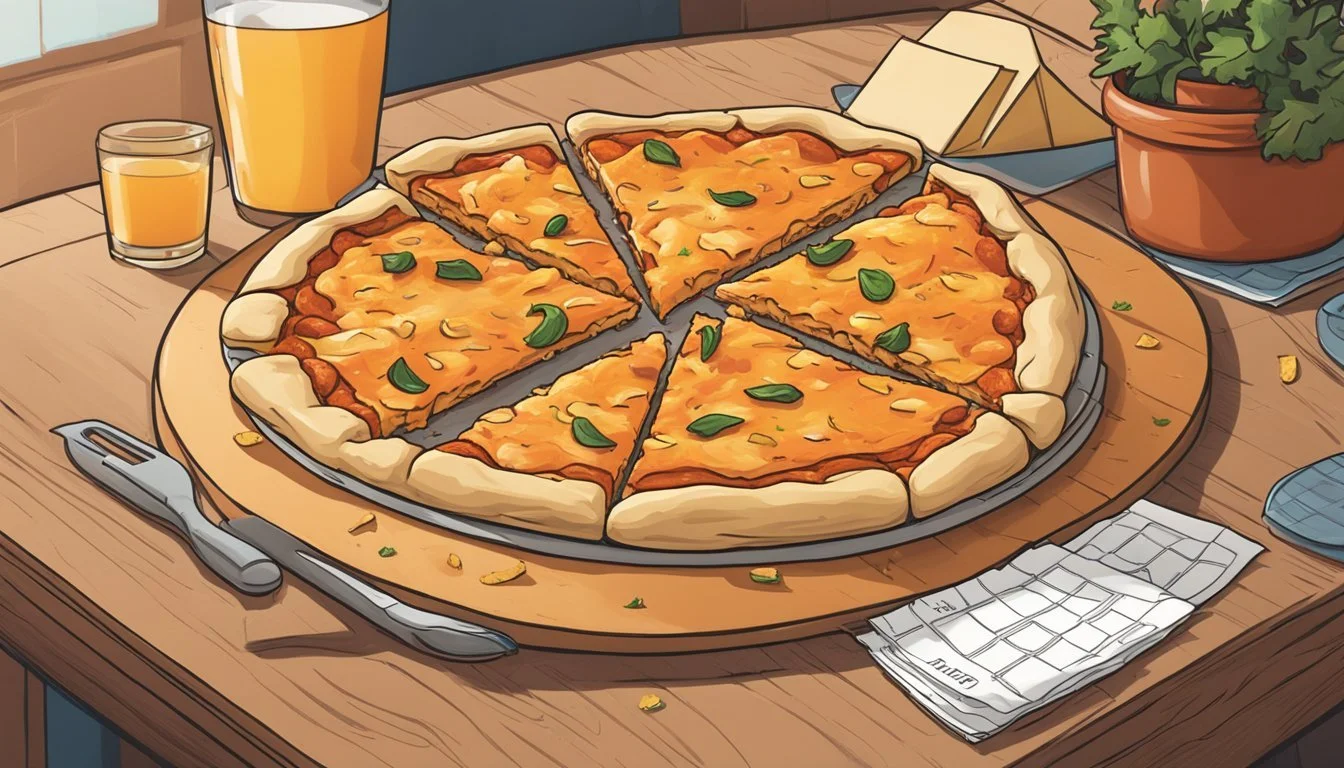How Long Does Buffalo Chicken Pizza Last?
Storage Tips and Shelf Life
Buffalo chicken pizza, a delightful fusion of spicy chicken and classic pizza flavors, is a crowd favorite for both game days and family dinners. Properly storing buffalo chicken pizza can ensure it lasts up to four days in the refrigerator. This storage time allows you to enjoy leftovers without compromising on taste and safety.
To maximize its shelf life, store the pizza in airtight containers or tightly wrap it in aluminum foil or plastic wrap. These practices prevent exposure to air, maintaining the pizza's moisture and flavor. If you have more pizza than you can eat within a few days, consider freezing it, where it can last for up to two months while retaining its quality.
Knowing these storage tips ensures you get the most out of your buffalo chicken pizza without unnecessary waste. A well-stored pizza retains its deliciousness, making every bite as enjoyable as the first.
Overview of Buffalo Chicken Pizza
Buffalo Chicken Pizza combines spicy buffalo chicken with savory pizza elements to create a delicious fusion. This dish has grown in popularity thanks to its unique flavor and versatility.
History of Buffalo Chicken Pizza
Buffalo Chicken Pizza originated in the United States as a creative fusion of two beloved foods: buffalo chicken wings and pizza. It gained popularity in the late 20th century, partly due to the increasing popularity of buffalo wing sauce, which was invented in Buffalo, New York, in the 1960s. As people sought new ways to enjoy the spicy and tangy flavor of buffalo wings, integrating these flavors into a pizza became a natural evolution.
Popularity Among Foodies
Buffalo Chicken Pizza has become a staple in many pizzerias and homemade pizza recipes due to its bold flavor profile. Food enthusiasts appreciate the balance of spicy buffalo sauce, creamy ranch or blue cheese dressing, and tender chicken. This pizza variety often features in food blogs, cooking shows, and social media, where foodies share their own twists on the classic. Its appeal extends to those who love experimenting with new flavors while retaining the comfort of a familiar dish.
Key Components
Ingredients:
Chicken: Typically cooked and shredded or cubed buffalo chicken.
Buffalo Sauce: A mixture of hot sauce, usually Frank's RedHot, and butter.
Cheese: Mozzarella is common, with some opting for a blend that includes blue cheese.
Dressing: Ranch or blue cheese dressing is often used as a base sauce or a drizzle.
Dough: Standard pizza dough serves as the base, either homemade or store-bought.
Preparation:
Sauce Preparation: The buffalo sauce is a key element, combining hot sauce with butter and spices.
Layering: The dough is first spread with ranch or blue cheese dressing, followed by the buffalo chicken, and then topped with cheese.
Baking: The pizza is typically baked in an oven preheated to high temperatures until the crust is crisp and toppings are bubbly.
This section delves into the essentials of Buffalo Chicken Pizza, covering its origins, wide appeal among casual eaters and foodies alike, and the critical aspects that make it a favorite.
Nutritional Profile
Buffalo chicken pizza provides a blend of flavors while also offering various nutritional components. This section goes into key details about its caloric content, macronutrient breakdown, and dietary considerations.
Caloric Content
A single large slice of buffalo chicken pizza typically contains around 350 calories. These calories derive from various ingredients, such as the crust, cheese, chicken, and buffalo sauce.
Comparing brands, Domino's buffalo chicken pizza has approximately 351 calories per slice. The caloric value can vary slightly due to portion sizes and ingredient variations.
Macronutrients
Buffalo chicken pizza presents a distinctive macronutrient profile. A standard slice includes:
Carbohydrates: 37% of the calorie content comes from carbs, mainly due to the crust and sauce.
Fat: 44% of the calories stem from fats. This includes saturated, monounsaturated, and polyunsaturated fats, primarily from mozzarella and blue cheese.
Protein: Roughly 19% of the calories come from protein. The chicken topping is a significant source of protein, contributing to its relatively high protein content.
Dietary Considerations
Individuals should consider sodium content as one slice can contain significant sodium levels, often from both the cheese and buffalo sauce.
Allergens: Common allergens include dairy (mozzarella, blue cheese) and gluten (crust).
Nutrient contributions include calcium and Vitamin A, which are beneficial. However, the high fat and sodium levels should be moderated, especially for those with specific dietary restrictions.
Preparation Tips
Proper preparation of buffalo chicken pizza involves selecting fresh ingredients, making homemade dough, and preparing the buffalo chicken topping with care.
Selecting Ingredients
Fresh and high-quality ingredients make a significant difference in the taste of buffalo chicken pizza.
Chicken: Use freshly-cooked chicken breast, thighs, or rotisserie chicken. Ensure the chicken is tender and well-seasoned.
Cheese: Opt for mozzarella cheese for its melting quality. Add blue cheese or parmesan for extra flavor.
Buffalo Sauce and Dressing: Use a mix of buffalo sauce and ranch or blue cheese dressing. Adjust the heat according to taste.
Vegetables: Include red onions, bell peppers, or celery as toppings to add texture and flavor.
Homemade Pizza Dough
Creating homemade dough ensures a fresh and customizable base for the pizza.
Ingredients: Use high-quality flour, yeast, water, olive oil, and salt.
Preparation: Combine the ingredients and knead the dough until smooth and elastic. Let it rise until it doubles in size, which usually takes about an hour.
Shaping: Roll the dough on a floured surface into your preferred shape. Prebake if desired for a crispier crust.
Storage: If not using immediately, wrap the dough in beeswax wrap and refrigerate for up to 24 hours.
Buffalo Chicken Preparation
For the buffalo chicken topping, start with tender, well-cooked chicken.
Cooking Method: Bake or grill the chicken until fully cooked. Leftover or rotisserie chicken can be used for convenience.
Buffalo Sauce Mixture: Toss the cooked chicken with a combination of buffalo sauce and ranch or blue cheese dressing.
Application: Spread the sauce-coated chicken evenly over the prepared pizza dough. Top with mozzarella and other chosen toppings.
Baking: Preheat the oven to a high temperature, around 475°F. Bake the pizza until the cheese is melted and bubbly, and the crust is golden brown, typically 10-15 minutes.
Baking and Cooking Techniques
Mastering the baking and cooking techniques for buffalo chicken pizza ensures a perfect blend of flavors and textures. Key methods include oven baking, using a pizza stone, and exploring alternative cooking methods to suit different kitchen setups and preferences.
Oven Baking Method
Oven baking is a popular method that delivers a crispy crust and evenly cooked toppings. Preheat the oven to around 450°F (230°C) for optimal results. If using homemade pizza dough, parbake the crust for 8-9 minutes until it just begins to turn golden brown. This technique prevents the dough from becoming soggy when topped with sauce, chicken, and mozzarella.
Once the crust is parbaked, remove it from the oven. Spread the buffalo sauce evenly, then add shredded mozzarella and pre-cooked buffalo chicken. Bake the assembled pizza for another 10-15 minutes until the cheese is melted and bubbly, and the crust is fully cooked. Using a pizza pan can help maintain the pizza’s shape and even out the heat distribution.
Cooking on a Pizza Stone
A pizza stone can elevate homemade pizza by providing a crispy, well-cooked crust similar to that of a traditional pizzeria. Preheat the pizza stone in the oven at the highest temperature possible, typically around 500°F (260°C). Allow the stone to heat for at least 30 minutes to ensure it reaches the desired temperature.
Roll out the pizza dough on a lightly floured surface. Transfer the dough onto a floured pizza peel to avoid sticking. Spread buffalo sauce, followed by mozzarella and prepared chicken. Gently slide the pizza onto the preheated stone. Bake for 10-12 minutes until the crust is crisp and the cheese is thoroughly melted. The stone’s heat retention cooks the pizza evenly and gives it a distinguished texture.
Alternative Cooking Methods
For those without an oven or pizza stone, alternative cooking methods can be just as effective. Using a cast-iron skillet allows for a deep-dish style buffalo chicken pizza. Preheat the skillet on the stovetop before transferring it to a 450°F (230°C) oven. This technique replicates the heat from a pizza stone and ensures a crispy base.
Another method involves using a microwave to reheat leftover pizza. Place the pizza on a microwave-safe plate and cover it with a damp paper towel to maintain moisture. Microwave on high for 1-2 minutes until the cheese is melted. While this method is less ideal for fresh pizzas, it works well for quick reheating.
Storage Guidelines
Proper storage is crucial for maintaining the freshness and safety of buffalo chicken pizza. Following the right methods for refrigeration and freezing can significantly extend its shelf life, preventing spoilage and foodborne illnesses.
Refrigeration Methods
Refrigeration is essential for short-term storage. Leftover buffalo chicken pizza should be stored in airtight containers or wrapped in aluminum foil or plastic wrap to prevent exposure to air and moisture.
Optimal temperature: Ensure the fridge is set at or below 40°F (4°C) to slow down bacterial growth.
Shelf life: Consume within 3-4 days. Check for signs of spoilage, such as mold growth, slimy texture, or discoloration. Inspecting for an off or sour odor can also indicate spoilage.
Reheating guidelines: Preheat the oven to 350°F (175°C) and bake for 10-15 minutes. Alternatively, use a microwave, heating in 30-second intervals until thoroughly heated.
Freezing Instructions
Freezing is ideal for long-term storage. To freeze, wrap slices individually in plastic wrap, then place them in freezer-safe bags or containers.
Optimal freezer temperature: Set the freezer at or below 0°F (-18°C). This halts bacterial growth and helps preserve the pizza's quality.
Shelf life: Can last up to 2 months in the freezer. Label containers with the date to keep track of storage time.
To reheat, thaw in the fridge overnight, then use an oven set at 350°F (175°C) for 15-20 minutes, or until the cheese is melted and bubbly. The microwave can also be used, heating in short bursts until hot.
Reheating and Serving
Reheating buffalo chicken pizza correctly ensures it retains its flavor and texture. Serving suggestions can enhance the taste experience, making the meal more enjoyable.
Best Reheating Practices
When reheating buffalo chicken pizza, maintaining the balance of moisture and crispness is essential. For oven reheating, preheat the oven to 350°F (175°C). Place the pizza on a baking sheet and heat for 10-15 minutes until the cheese melts and the crust is crisp.
Using a microwave, heat the pizza on high for 2-3 minutes. To avoid sogginess, place a cup of water in the microwave to absorb excess moisture. For a skillet, heat on medium and cover the pan, cooking for about 5 minutes or until the cheese melts.
Serving Suggestions
Serve buffalo chicken pizza with fresh toppings for added flavor and texture. Sprinkling freshly chopped scallions over the pizza can provide a subtle sharpness. A drizzle of ranch dressing or blue cheese dressing complements the spicy buffalo sauce and enhances the overall taste.
Pair the pizza with a side of celery or carrot sticks for a refreshing crunch. For a richer experience, consider adding extra buffalo sauce or a sprinkle of grated cheese before serving.
Safety and Spoilage Indicators
Buffalo chicken pizza, like all perishable foods, has specific signs indicating its safety and spoilage. These include physical changes, such as mold and discoloration, as well as sensory indicators like odor and texture.
Identifying Spoilage
Visible mold or discoloration on the pizza is a clear indicator of spoilage. Mold can take on various colors, but any presence of it means the pizza is unsafe to eat.
Odor is another significant spoilage indicator. Spoiled buffalo chicken pizza often emits a sour or off smell, distinct from its usual aroma.
Texture changes can also signal spoilage. A slimy texture on the cheese or crust is a common sign that the pizza has gone bad. Always inspect these indicators before consuming leftover pizza.
Preventing Contamination
Proper storage is key to preventing contamination and extending the pizza's shelf life. Refrigerating buffalo chicken pizza promptly after it's cooled down is crucial. Ensuring the fridge temperature remains at or below 40°F (4°C) helps maintain its freshness.
Using airtight containers or tightly wrapping the pizza in aluminum foil or plastic wrap minimizes exposure to air and contaminants. Labeling the storage date is also helpful to keep track of its age.
Reheating the pizza to an internal temperature of 165°F (74°C) before consumption is important. This ensures any potential bacteria are killed, making it safe to eat. Always use a food thermometer to verify the temperature.
Creative Variations and Recipes
Incorporating various toppings, trying new Buffalo chicken-styled dishes, and even exploring vegetarian alternatives can offer unique and delicious twists on the traditional Buffalo Chicken Pizza.
Customizing Toppings
Experimenting with toppings can elevate the flavor profile of your Buffalo Chicken Pizza. Adding red onions and green onions can provide a fresh, zesty contrast to the spiciness. Jalapeños can introduce an extra kick for heat lovers.
For a more savory touch, tomatoes and cilantro make excellent additions. Consider a drizzle of ranch or blue cheese dressing after baking to enhance the creamy and tangy aspects. Mixing cheeses like mozzarella and parmesan can also add depth and richness to the pizza.
Buffalo Chicken-Styled Dishes
Buffalo chicken flavor can be enjoyed in many other dishes besides pizza. Buffalo chicken dip is a popular choice for parties, offering the same spicy tang in a dippable format. For a heartier meal, try buffalo chicken pasta or buffalo chicken mac and cheese, both of which marry the creamy textures of pasta with the bold flavors of buffalo sauce.
Alternatively, bbq chicken pizza can be modified by swapping BBQ sauce for buffalo sauce, creating a new twist on a classic favorite.
Vegetarian Alternatives
For those who prefer vegetarian options, there are numerous ways to enjoy similar flavors without the chicken. Buffalo cauliflower can be used as a topping for pizza, offering a similar texture and spice. Combine grilled vegetarian-friendly toppings like tomatoes, green onions, red onion, and jalapeños with buffalo-style sauces to replicate the dish's essence.
Buffalo chickpea pizza is another great alternative, using seasoned chickpeas to replace the chicken while still soaking up the buffalo flavors. Adding a generous amount of mozzarella and other cheeses ensures the pizza remains rich and delicious.
Pairings and Occasions
Buffalo chicken pizza is versatile and pairs well with a variety of beverages. It is popular for activities like watching sports and casual gatherings.
Beverage Pairings
The spicy and creamy elements of buffalo chicken pizza call for drinks that can balance and complement these flavors. Beer is an excellent choice, especially light lagers or ales, as they enhance the spiciness while providing a refreshing contrast. For those who prefer non-alcoholic options, iced tea or lemonade can cut through the richness of the cheese and sauce. Also, milk is a good option for those sensitive to spice, providing a soothing counterbalance.
Beverage Reason Light Lager Refreshes palate and enhances spice Iced Tea Cuts through richness Lemonade Provides a tangy contrast Milk Neutralizes spiciness
Appropriate Events
Buffalo chicken pizza shines during casual, social occasions. Game days and watching sports events, particularly football, are ideal for this robust pizza. The combination of gooey cheese and spicy chicken is a crowd-pleaser, perfect for shared dining and quick delivery. It’s also great for family movie nights or weekend gatherings where easy and flavorful food is a priority. The quick and easy preparation makes it a convenient option for hosting a relaxed evening with friends.
Game Day: Perfect alongside beer and chips
Sports Viewing: Casual sharing food
Family Gatherings: Enjoyed by adults and kids
Weekend Parties: Easy to serve and eat
Homemade vs. Delivery
Choosing between making buffalo chicken pizza at home or opting for delivery hinges on factors like freshness, control over ingredients, and time investment. Both methods have unique advantages and should be evaluated based on individual priorities.
DIY Advantages
Making buffalo chicken pizza at home allows for greater control over ingredients and customization. Home chefs can use a recipe card to manage every step, from creating the homemade dough to adjusting the level of heat in the sauce. Freshness is another benefit; homemade pizzas can be enjoyed straight out of the oven, ensuring a crispy crust and gooey cheese.
Preparation can be a family activity, enhancing the overall culinary experience. When making a homemade version, there is also the satisfaction of knowing what exactly goes into your meal, avoiding preservatives and other additives common in pre-made options. You have the freedom to experiment with various ingredients and cooking methods, adapting the recipe to personal tastes and dietary restrictions.
Choosing Delivery
Opting for delivery offers unmatched convenience and time-saving benefits. For those with a hectic schedule, ordering a buffalo chicken pizza can be done with a few taps on a smartphone, and a hot meal arrives at the doorstep with minimal effort. Delivery services often provide a wide array of choices, catering to different preferences and dietary needs quickly.
Delivery is particularly beneficial for individuals who may lack the tools or skills required for baking a pizza at home. The quality of the pizza might vary depending on the restaurant, but many pizzerias offer consistently high-quality options. While delivery pizzas might not be as customizable as homemade versions, they offer a reliable and quick solution for those craving buffalo chicken pizza without the need for preparation and cleanup.
Tools and Equipment
Creating Buffalo chicken pizza requires various tools and equipment to streamline the process efficiently. Basic kitchenware and advanced pizza-making tools are crucial for achieving the best results.
Essential Kitchenware
Baking Sheet: A standard baking sheet is necessary for those who do not own a pizza stone. It provides a flat surface for baking the pizza and ensures even cooking.
Oven: An oven that can reach high temperatures (around 400°F-920°F) is important. Higher temperatures yield better crust texture.
Microwave: Softening cream cheese or melting small amounts of butter can be done quickly using a microwave.
Mixing Bowls: Various sizes are needed for mixing ingredients like ranch dressing, buffalo sauce, and shredded chicken.
Skillet: Useful for making sauces. For example, melting butter and combining it with spices can easily be done in a skillet.
Advanced Pizza-Making Tools
Pizza Stone: Provides a superior baking surface compared to a baking sheet. It absorbs moisture, resulting in a crispy crust. Preheat the stone in the oven for the best results.
Pizza Peel: Essential for transferring pizza to and from the oven, especially when using a pizza stone. The wide, flat surface helps move the pizza without disturbing the toppings.
Instant Pot: This can be used to quickly cook chicken if desired. It speeds up the process of preparing the chicken, especially when tight on time.
Stand Mixer: Ideal for kneading the pizza dough if making from scratch. It saves time and ensures the dough is well-mixed.
By utilizing these tools and equipment, creating Buffalo chicken pizza becomes straightforward and efficient, leading to a delicious homemade pizza with minimal hassle.
Troubleshooting Common Issues
Buffalo chicken pizza can face several problems during preparation and storage. Here are some common issues and solutions focusing on dough, cheese, sauce, and texture.
Dough-Related Challenges
Dough problems can range from being too tough to insufficiently rising. Homemade pizza dough needs proper kneading to develop gluten, which gives the pizza crust its chewy texture.
Issue: Tough dough
Solution: Ensure it is not over-kneaded, which makes it tough. Knead just until the dough is smooth and elastic, about 10 minutes by hand or 5-7 minutes using a mixer.
Issue: Insufficient rise
Solution: Check that the yeast is active. Use warm (not hot) water to activate the yeast and let the dough rise in a warm, draft-free area.
Cheese and Sauce Hiccups
Cheese and sauce can sometimes cause issues that affect the overall flavor and texture of the pizza. The type of cheese and sauce placement are crucial factors.
Issue: Cheese not melting properly
Solution: Use mozzarella for a classic, gooey cheese effect. Shred it yourself instead of using pre-shredded, which often contains anti-caking agents that hinder melting.
Issue: Sauce making the crust soggy
Solution: Use a minimal amount of sauce to prevent it from seeping into the dough. Make sure the sauce base is thick enough to sit on top of the dough without spreading.
Texture and Baking Setbacks
The final texture of the pizza can be influenced by the baking process and the ingredients used.
Issue: Soggy crust
Solution: Preheat the oven to a high temperature, ideally 450°F (230°C), to achieve a crispy crust. Also, consider using a pizza stone or pre-baking the crust for a few minutes before adding toppings.
Issue: Overdone or burnt edges
Solution: Keep an eye on the pizza towards the end of the baking time. Rotate it if the edges are cooking faster than the center. Cover the edges with foil if necessary to prevent burning.
Addressing these common issues can help you achieve a well-made buffalo chicken pizza with a perfect balance of flavors and textures.
Enhancing the Homemade Experience
Creating the perfect homemade Buffalo Chicken Pizza involves mastering the dough, achieving the right flavor balance, and presenting it in an appealing way. Attention to these details can elevate the quality and enjoyment of your pizza significantly.
Mastering the Dough
The foundation of any great pizza is its dough. Opt for a homemade dough to ensure freshness and flavor. Knead the dough thoroughly for a smooth texture. Allow it to rise for at least an hour, achieving a light and airy base.
When ready to bake, preheat the oven to a high temperature, around 450°F (230°C). Baking on a preheated pizza stone can help achieve a crispy crust. For an extra touch, brush the edges with olive oil before baking.
Flavor Balancing
Balancing flavors in a Buffalo Chicken Pizza is crucial. Start with a base of buffalo sauce and ranch dressing for a creamy, tangy contrast. Use spicy chicken prepared with buffalo wing sauce for the topping.
Add a mixture of cheeses like fresh mozzarella and blue cheese crumbles or gorgonzola for depth. Consider adding a sprinkle of bacon for a smoky touch. Balance the heat of the buffalo sauce with a drizzle of ranch or blue cheese dressing after baking.
Presentation Tips
Presentation matters as much as taste. Garnish your pizza with scallions or green onions for a pop of color. Parsley can add a fresh, vibrant touch. Arrange the chicken and toppings evenly to ensure each slice has a bit of everything.
Adding a final drizzle of sauce, whether it's more buffalo or a creamy dressing, can enhance both the look and flavor. Thinly sliced bacon or extra blue cheese can serve as a visually appealing and flavorful garnish.
By focusing on these aspects, your homemade Buffalo Chicken Pizza will be a standout dish that's both delicious and visually appealing.




